OUR TOP TEN MOST IMPORTANT JAGUARS
Reproduced with permission of Jaguar World magazine (Summer 2018)
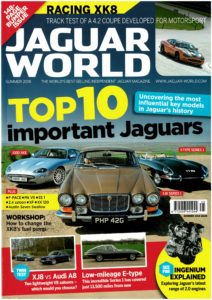
Jaguar World
Summer 2018
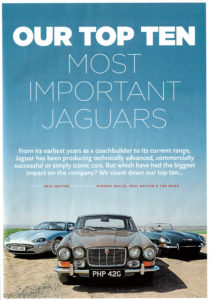
Our Top Ten
Most Important Jaguars
Six cars from the Jaguar Daimler Heritage Trust’s Collection appeared in the Jaguar World Top 10 article published in Summer 2018.
From its earliest years as a coachbuilder to its current range, Jaguar has been producing technically advanced, commercially successful or simply iconic cars.
But which have had the biggest impact on the company?
We count down our top ten….
Number 10 – F-PACE
(not from JDHT collection)
Number 9 – Mk VII – (464 HYV)
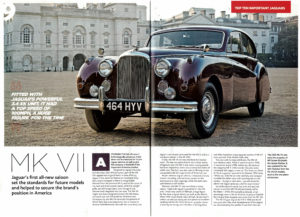
Jaguar World – Summer 2018
Top 10, Car 9, Mk VII – 464 HYV
Jaguar’s first all-new saloon set the standards for future models and helped to secure the brand’s position in America.
ALTHOUGH THE Mk VII wasn’t technologically advanced, it laid down the foundations for future Jaguar saloons, as well as give the company a foothold in the important American market.
Designed by Jaguar’s founder and chairman (Sir) William Lyons, part of the Mk VII’s appeal was its good looks. In spite of being Jaguar’s first saloon to feature an enveloped body style, Lyons managed to blend in recognisable features from the previous Mk V, such as the curve of the roof and three-quarter panel, while the upright grille was still recognisable, even though it was slimmer and integrated into the nose. The Mk VII might have been designed primarily for the States, but Lyons was not influenced by American cars. Consequently, the Mk VII remained the epitome of British style and understatement, free of excessive chrome embellishments. Beneath the curvy body was Jaguar’s new chassis (also used for the Mk V, and as a cut-down version in the XK 120).
Inside, the Mk VII set new standards for interior room. The rear occupants had an extra three inches of legroom over the Mk V and, since running boards had been dispatched, there was an extra five inches of width, too. The boot was also vast: at 4ft long, it was comparable with the huge trunks of American cars.
As per previous Jaguar saloons, it featured a luxury interior, including polished wood veneer on the dashboard and door cappings, while the seats were upholstered in soft leather.
However, the Mk VII was more than a luxury saloon. Fitted with Jaguar’s powerful 3.4-litre XK unit, it had a top speed of 100 mph, a huge figure for the time; a typical family car, such as the Morris Minor MM, could barely reach 65 mph. Its size didn’t make it an obvious racing car, but speed and excellent handling led the Mk VII to become a popular choice in touring car racing, with the likes of Stirling Moss and Mike Hawthorn enjoying great success. A Mk VII even won the 1956 Monte Carlo rally.
Yet even with its many attributes, the Mk VII was fabulous value. When it went on sale in 1950, it was priced at just £998, before tax, the same as the outgoing Mk V. Little wonder the press were impressed with Jaguar’s new car. The American Road & Track magazine reported in its October 1952 issue, “When you look the car over carefully, and compare its dollar-for-dollar value with anything else on the market – foreign or domestic – you are bound to admit that Jaguar gives you a lot for your money.”
Its combination of speed, low price and spacious interior meant the Mk VII sold particularly well in the States – of the 32k examples produced, a high percentage went to North America, helping to establish the marque there arguably even more than the XK120.
The Mk VII gave way to the VIII in 1956 and the IX two years after that, both developments of the original car, demonstrating how perfect it was from the start.
This 1955 Mk VII was once the property of HM Queen Elizabeth, the Queen Mother. It was updated for her with features from the Mk VIII/IX models, such as the one-piece windscreen.
Number 8– SS 1 (not from JDHT collection)
Number 7 – X100 XK8 – (XK05 JAG)
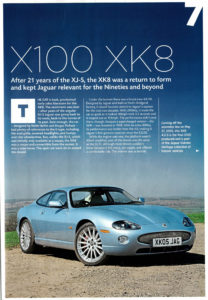
Jaguar World
Summer 2018
Top 10, Car 7, X100
XK05 JAG
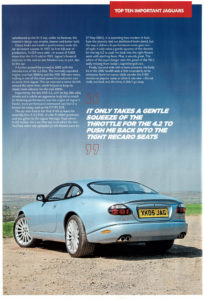
Jaguar World
Summer 2018
Top 10, Car 7, X100
XK05 JAG
After 21 years of the XJ-S, the XK8 was a return to form and kept Jaguar relevant for the Nineties and beyond.
THE CAT is back, proclaimed early sales literature for the XK8. The sentiment was clear – after years of the angular XJ-S Jaguar was going back to its roots, back to the curves of its past. Sure enough, the car – designed by Keith Helfet and Fergus Pollock – had plenty of references to the E-type, including the oval grille, covered headlights, and humps over the wheelarches.
But, unlike the XJ-S, which was initially only available as a coupe, the XK8 was a coupe and convertible from the outset. It was a wise move. The open car went on to outsell the closed.
Under the bonnet there was a brand new 4.0 V8. Designed by Jaguar and built at Ford’s Bridgend factory, it would become central to Jaguar’s success for the next two decades. With 290 bhp, it made the car as quick as it looked: 60 mph took 5.2 seconds and it topped out at 155 mph.
The performance didn’t end there, though, because a supercharged version – the XKR – was revealed in 1998. With an extra 80 bhp, its performance was harder than the 4.0, making it Jaguar’s first genuine supercar since the XJ220.
While the engine was new, the platform wasn’t. Albeit modified, part of the chassis was the same as the XJ-S’, although most drivers wouldn’t know because it felt sharp, yet supple, and offered a comfortable ride. The interior was as lavishly upholstered as the XJ-S but, unlike its forbear, the interior’s design was simpler, cleaner and better built.
Classic looks and modern performance made the car an instant success. In 1997, its first full year of production, 14,929 were sold – in excess of 9,000 more than the XJ-S sold in 1995. Jaguar’s financial recovery in the mid-to-late Nineties was, in part, due to this car.
A further powerhike arrived in 2002 with the introduction of the 4.2-litre. The normally aspirated engine now had 300 bhp and the XKR 100 even more, making it one of the most powerful production cars to come from Jaguar. The car received a minor facelift around the same time, which helped to keep its classic looks relevant for the mid-2000s.
Importantly, the late XKR 4.2, with its big 20in alloy wheels and a subtle yet aggressive body kit to match its blistering performance, was the origins of Jaguar’s harder, more performance-orientated cars that it is known for today, such as the F-TYPE SVR.
The car seen here is the final X100 to leave the assembly line. A 4.2 XKR, it’s the 91,406th produced, and was gifted to the Jaguar Heritage Trust where it still resides. For a car that was built when the first YouTube video was uploaded (it left Browns Lane on 27 May 2005), it is surprising how modern it feels. Sure the clumsily laid out dashboard looks dated, but the way it delivers its performance never goes out of style: it only takes a gentle squeeze of the throttle for the big 4.2 to push me back into the tight Recaro seats with startling force. Plus, it sounds great. The whine of the supercharger over the growl of the V8 is sadly missing from today’s supercharged cars.
Finally, low and wide with a mean presence, the body kit of the 2002 facelift adds a little muscularity to its otherwise feminine curves. Little wonder the X100 remains as popular today as when it was new – the cat really was back and, this time, it didn’t go away.
IT ONLY TAKES A GENTLE SQUEEZE OF THE THROTTLE FOR THE 4.2 TO PUSH ME BACK INTO THE TIGHT RECARO SEATS.
Coming off the assembly line on May 27, 2005, this XKR 4.2-S is the final X100 produced and is part of the Jaguar Daimler Heritage collection of historic vehicles.
Number 6 – 2.4 SALOON (not from JDHT collection)
Number 5 – XF – (BX08 VCP)
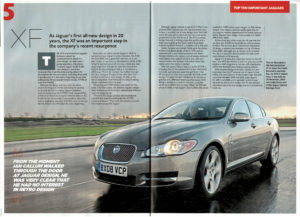
Jaguar World – Summer 2018
Top 10, Car 5, XF – BX08 VCP
As Jaguar’s first all-new design in 20 years, the XF was an important step in the company’s resurgence.
THE XF’S importance on Jaguar’s fortunes cannot be underestimated. Stuck in a retro-design rut that wasn’t going anywhere, the saloon returned Jaguar to the fresh, new designs it was once renowned for. It set the tone and lay down the foundations for future models, including those still in production. It’s not such a huge leap to say that without the XF, we wouldn’t have the XJ, F-TYPE or even the F-PACE.
Although the design was new, what lay below wasn’t. Running out of time and money to develop an all-new aluminium chassis, Jaguar’s engineers were forced to reuse the S-TYPE’s Ford-sourced DEW architecture. However, as anyone who has driven a 4.2 R will tell you, dynamically it was excellent, albeit the interior packaging was poor, with little room in the rear. Yet the chassis was a fine basis for a new beginning.
Ever since Ian Callum joined Jaguar in 1999 he wanted to move Jaguar in a new direction. His X150 XK from 2005 was a good first start but, as a two-door coupe, it was clearly a development of the X100. What he wanted was an all-new car, a bold step that shied away from the past to leave the retro phase behind. As Wayne Burgess told us in February 2013 issue, “From the moment Ian walked through the door in Jaguar Design, he was very clear that he had no interest in retro design. He felt, as did the existing team, that there was no value in taking design inspiration from the past.”
Producing an S-TYPE Series 2 was never on the cards. From the outset, the sketches Jaguar’s design team showed parent Ford were substantially different from the outgoing car.
“Never in the design process did we produced a model that looked anything like the S-TYPE,” continued Wayne. “They were all variations around the modern coupe-like Jaguar.”
Although Jaguar needed to use the S-TYPE’s Ford-sourced DEW architecture, the rest was totally new. In fact, it was the first all-new design since the XJ40 some 20 years earlier, but even that had had similar proportions to the XJ6 Series 3. The XF’s eventual design featured a striking coupe-like profile and a large square grille at the front, said to have been inspired by the XJ Series 2 – a subtle nod to the past.
Inside, the past was ousted. Gone were the clunky buttons and dated design of the S-TYPE and XJ, replaced with a contemporary layout with flush-fitting switches and a cleaner overall design. Callum’s team added some playful touches, too, such as a starter button that pulsates red and air vents that rotate when the engine is started.
With the same choice of engines as the S-TYPE – including the 2.7-litre diesel and 4.2-litre V8 in both aspirated and supercharged form – the XF was great to drive too, especially the SV8, which feature the latter. It wasn’t badged an R, but was as good as one, offering blistering performance. With 60 mph reached in a mere 5.1 seconds, it put the car firmly in BMW M5 territory. When the XFR did arrive in 2009, it had Jaguar’s new 5,000 cc V8, which resulted in 510 PS when supercharged. Its 20 in alloys, deeper front valance and rear spoiler gave the car the tougher, meaner appearance that would come to define Jaguar’s new image, most notably the 550 PS XFR-S from 2013.
At the other end of the scale, the XF was the first car since the X-TYPE to be produced with economy in mind. The 2.2-litre diesel returned an impressive 52.3 mpg, a massive improvement on the 3.0 diesel from 2009. Although not as refined as the smooth V6, the 2.2 was still a decent performer and could reach 60 mph in 9.8 seconds.
Jaguar’s first executive estate was based on the XF, too – the 2012 Sportbrake. It had not been part of the original model programme, but was still a handsome estate that featured class-leading loading abilities.
With modern design and many variants, it’s not surprising that the XF became one of Jaguar’s best-selling executive saloons of the modern age: 202,678 were sold between 2009 and 2016 (sales figures for 2007 and 2008 aren’t available) before it was replaced by the current model. The XF was not just important due to its new design, but on a commercial level, too.
The car illustrated is the first production XF to leave the Castle Bromwich assembly line. An SV8 in Vapour Grey, it was built on 26 November 2007 and today forms part of the Jaguar Daimler Heritage Trust.
Number 4 – Austin Seven Swallow – (FV 137)
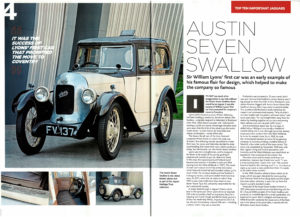
Jaguar World – Summer 2018
Top 10, Car 4
Austin Seven Swallow – FV 137
Sir William Lyons’ first car was an early example of his famous flair for design, which helped to make the company so Famous.
IT’S NOT too much of an exaggeration to say that without the Austin Seven Swallow there would be no Jaguar; it was the success of William Lyons’ first car that prompted his company’s move to Coventry.
Lyons and his business partner, William Walmsley, had been building a handsome, aluminium sidecar (the Swallow – originally designed by Walmsley) in Blackpool since 1922, which became popular with motorcyclists wanting a stylish and sporty sidecarriage. However, both were aware that the birth of the reliable yet diminutive Austin Seven – a clear rival to the motorbike-and-sidecar combination – would affect sales.
The Seven, like all cars of the time, featured a separate frame chassis on which the body was dropped, thus allowing specialists to create their own. So, Lyons and Walmsley decided to enter coachbuilding and create their own, which would be a cheap, but fashionable, car: the Austin Seven Swallow.
Lyons was not a draughtsman, and he designed his Seven as he would all his cars by guiding an experienced tinsmith to put his ideas into metal, in this case, the experienced Cyril Holland (Cyril became instrumental in Swallow’s early cars after moving from the West Midlands in 1927). The result of their work was an extremely pretty two-seater, which featured a bowl tail and rounded radiator grille cowl. Inside, the standard dashboard has Swallow’s mahogany version, and Lyons added more luxurious seats. At £175, when the car went on sale in May 1927 it was a mere £30 more than Austin’s own Seven Tourer Type AD, and partly responsible for the car’s reasonable success.
A major breakthrough in Jaguar’s history came later in the same year when Lyons drove an example 250 miles to London (itself an impressive feat) for a meeting with Frank Hough and Bertie Henly, partners of the new dealership Henlys. Impressed by the little car, the pair immediately ordered 500 cars – including a saloon, which they saw as essential.
Production was increased to 12 cars a week, but it was soon obvious that Swallow’s current factory wasn’t big enough to meet the order. In fact, Blackpool’s train station became clogged with Austin Seven chassis that Swallow’s factory didn’t have room to accommodate. The workforce did the best it could, retrieving the chassis in an unconventional manner. “Why we didn’t run into trouble with the police I will never know,” said Lyons years later, “for we brought them away from the station by hooking together six at a time and towing them behind a car, even at peak traffic hours.”
Just as pressing as space was the shortage of skilled labour. Blackpool was hardly a hotbed of coachbuilding talent and, although Lyons had already employed some workers from the West Midlands, he knew he needed more. So, in 1928, he took the monumental decision to move his burgeoning company to Coventry, finding a suitable factory in Foleshill, a few miles north of the town centre. The move was completed by November 1928 and, with that, Jaguar’s long and fruitful association with Coventry and the West Midlands was established, an association that continues to the present day.
The extra room and increased workshop saw production improve, but it took hard work. “It was a most exciting time,” Lyons later said. “We worked from 8 o’clock in the morning until 11 o’clock at night as we tried to raise production from 12 a week to 50 within three months.”
In late 1928, Swallow added a Seven saloon to its range, which was again designed by Lyons guiding Cyril Holland. With its low-slung looks and the bright two-tone colour schemes, it was a far cry from the Austin’s upright standard model.
Production of the Austin Seven Swallow finished in 1931, when Lyons moved into car manufacturing with the SS 1. Around 4,000 examples of the Seven Swallow were produced, an incredible figure for a small coachbuilder and testament to Lyons’ skill as a designer and businessman. While those skills would see him create some of the finest cars in the history of the automobile, it started with the diminutive Austin Seven Swallow.
This Austin Seven Swallow is the oldest known saloon and is part of the Jaguar Heritage Trust collection.
Number 3 – XJ6 Series 1 – (PHP 42G)
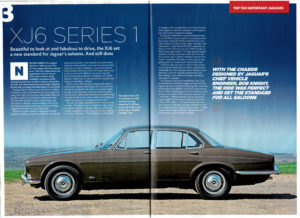
Jaguar World – Summer 2018
Top 10, Car 3, XJ6 – PHP 42G
Beautiful to look at and fabulous to drive, the XJ6 set a new standard for Jaguar’s saloons. And still does.
NOTHING ABOUT the original XJ6 from 1968 was new. The 4.2-litre engine had been around since 1964, the independent rear suspension was first seen in 1961, and the classic quad headlights and square grille treatment came from the Mk X and was reused for the 420. Yet when everything was brought together for the XJ6, it created the finest saloon in the world.
Designed by Sir William Lyons (his final car before he retired in 1972) and based on an early E-type 2+2 study from 1962, the XJ6 was much smaller than the ponderous Mk X and had better proportions than the 420, even though it shared many design cues with both. Its delicate, simple detailing, such as the slim chrome bumpers and body-coded steel wheels, heightened its sense of understated style.
Thanks to its slim pillars, the glass area offered excellent visibility for the time, while the interior was clearly laid out with a row of black-and-white Smiths dials and rocker switches. However, that was not what made the car such a standout – it was how it drove. With 245 bhp from the 4.2-litre XK engine (there was a 2.8, too, but with 180 bhp it was never popular), performance was excellent. Its 0-60 mph time of 8.8 seconds made it fast for the period and it could cruise all day comfortably at 70 mph.
What’s more, with the chassis designed by Jaguar’s chief vehicle engineer, Bob Knight, the ride was perfect and set the standard for all saloons. It was both supple enough to absorb bumps instead of transmitting them into the cabin, while at the same time being stiff enough to hustle the car round a corner without the feeling you might float away, as in the larger and softer Mk X.
The car was highly applauded when it went on sale in 1968. “We believe that in its behaviour it gets closer to overall perfection than any other car we have yet tested, regardless of price, “reported Motor magazine in its May 1969 issue. “if not faultless, it is impossible to charge it with any significant criticisms, but even when judged by absolute standards, and its tally of top marks makes impressive reading.”
Driving the Sable Brown example featured here (a car Sir William Lyons’ used for several years after choosing it randomly off the production line, and which today forms part of the Jaguar Heritage Trust collection) it’s clear that all the XJ6’s applauds are still true. While the car is an early 1969 example, it feels surprisingly modern. The large glass areas give excellent visibility, more than other cars from the era, and the ease in which it delivers its power is to modern standards. The ride is as first-class as ever, gliding over our uneven road surfaces with ease.
There are only two areas in which it feels dated: on a warm and sunny day the interior can become unbearably hot, the large glass areas letting in more light than a Spanish vegetable greenhouse, and steering is over-assisted by today’s standards, although it is accurate.
Ten minutes with the car exemplifies why it set the standards for all future Jaguar saloons and why Jaguar was able to extend its life long after most cars would have been replaced. The Series 1 gave way to the Series 2 in 1973, addressing some of its few issues, such as better ventilation. With its all-new replacement – the XJ40 – behind schedule, the car was given a major facelift by Pininfarina resulting in the Series 3 from 1979, which, in V12 form, lasted until the early Nineties. Although markedly old-fashioned by then, what made the original XJ6 so perfect in 1968, mainly a subtle style, first-class ride and excellent performance, was still highly desirable.
This Sable Brown XJ6 4.2 featured is a 1969 example that was owned by Sir William Lyons and today is part of the Jaguar Daimler Heritage Trust.
Number 2 – XK 120 (not from JDHT collection)
Number 1 – E-TYPE SERIES 1 – (77 RW)
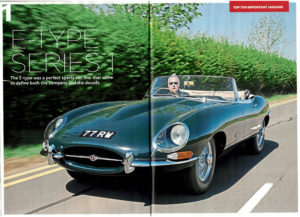
Jaguar World – Summer 2018
Top 10, Car 1, E-type – 77 RW
The E-type was a perfect sports car, one that came to define both the company and the decade.
IT COULDN’T really be anything else, could it? Easily Jaguar’s most famous model in its 96-year history, the E-type has come to characterise the company, the sports car genre as a whole, and the swinging Sixties. Even now, the E-type continues to be chosen for advertising purposes and is regularly driven by the protagonist in films, all of which continue to raise Jaguar’s profile more than any of today’s’ models.
The most obvious reason it became so famous is its stunning looks. The work of Jaguar’s genius aerodynamicist Malcolm Sayer, who drew upon his experience designing the all-conquering C- and D- types, its long bonnet, glass-covered headlights, elegant noise and beautifully tapered rump were like nothing else at its reveal to an astonished audience at the 1961 Geneva show. They were more used to such contemporary sports cars as the comparatively cumbersome Aston Martin DB4. Not even the Italians were producing anything with such delicate lines, and Enzo Ferrari famously described the E-type as, “The most beautiful car in the world.” The car still looks as amazing 57 years after it went on sale; it just hasn’t dated in the way you’d expect a car reaching six decades.
The other reasons the car made such as impact at the time was its performance. Powered initially by Jaguar’s 3.8 litre XK engine, the E-type had a claimed top speed of 150 mph (although was only proven when magazines tested a mildly modified coupe). Even so, it was a speed most cars could only dream of, and those that could were more expensive. When the car went on sale in the spring of 1961 at £2,160 it was an incredible £1,840 less than the DB4, fuelling the E-type’s legend.
Is it any surprise that the company couldn’t keep up with demand? At launch, Jaguar anticipated production figures of around 100 cars per week, a figure that turned out to be totally wrong. Jaguar had to increase its workforce in order to meet the orders that came flooding in, and was soon making 150 cars a week. In its first full year, 6,295 E-types were produced.
The car offers fabulous handling for the era – it was lightweight, due to its monocoque construction, and used Jaguar’s independent rear suspension, and front suspension developed from the D-type’s. Consequently, it had instant success as a racing car when, in its very first race at Oulton Park, Grand Prix driver Graham Hill won against stiff opposition from Aston Martin and Ferrari.
Its stunning appearance meant that, like the XK120 before it, the E-type quickly became the car to be seen in. In the early part of the Sixties, famous owners included Adam Faith, Frank Sinatra, Roy Orbison, George Best, Tony Curtis, George Harrison, John Barry, Johnny Halliday, Princess Grace, Charlton Heston and John Leyton, to name just a few. Even the British royalty bought into the E-type legend with the Duke of Kent owning a coupe. Such famous names advertised the E-type’s desirability and reputation, as did its appearance on the front cover of Dave Clark Five’s 1965 album, Catch Us If You Can, and its many starring roles in films. Its most famous appearances were in How to Steal a Million and the Italian Job.
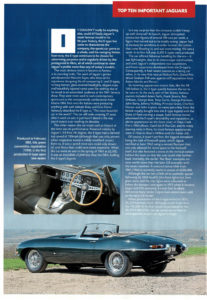
Jaguar World
Summer 2018
Top 10, Car 1, E-type
77 RW
Of course, it wasn’t perfect, the biggest complaint being the lack of footwell space which Jaguar rectified in June 1962 using a revised floorplan that not only allowed for more space in the footwell itself, but also featured a recess in the vertical section behind the seat so that the seat could slide further back. Ironically, the earlier ‘flat-floor’ examples are now worth more than the later 3.8 examples with the issues resolved. A restored convertible from 1961/1962 is currently worth in excess of £200,000 [at time of publication, Summer 2018].
Although the car lost a little of its aesthetic appeal following its 1968 facelift (the front lights lost their glass cover and the rear lights were relocated to below the bumper) and again in 1971 when it became larger and V12 powered, it never lost its allure. Almost as many Series 3 open-two-seaters were sold as the early 3.8 model.
When production of the E-type ended in 1975, 72,529 had been built. Although much fewer than the 115,330 XJ-Ss that would be produced or the 90,374 X100 XK8s, the car continues to have an immeasurable impact on Jaguar’s image.
Produced in February 1961, this green convertible, registration 77 RW, is the first production E-type open two-seater.
Words Paul Walton
Photography Michael Bailie, Paul Walton & Tom Wood